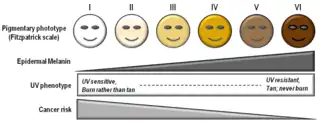Olive skin
Olive skin is a human skin colour spectrum. It is often associated with pigmentation in the Type III[1][2] to Type IV and Type V ranges of the Fitzpatrick scale.[3][4] It generally refers to light or moderate brown, brownish, or tan skin, and it is often described as having yellow, green, or golden undertones.[5][6][7][8][9][10][11][12][13]


People with olive skin can sometimes become more pale if their sun exposure is limited. Lighter olive skin still tans more easily than light skin does, and generally still retains notable yellow or greenish undertones.[14][15][16]
Geographic distribution
Type III pigmentation is frequent among populations from parts of the Mediterannean and Latin America.[1][17][18] It ranges from cream to darker olive[2] skin tones.[19] This skin type sometimes mildly burns and tans gradually, but always tans.[19][2]
Type IV pigmentation is frequent among populations from the Mediterranean, as well as parts of Asia and Latin America.[3][20] It ranges from brownish or darker olive[4] to moderate brown, typical Mediterranean skin tones.[21] This skin type rarely burns and tans easily.[19]
Type V pigmentation is frequent among populations from the Middle East,[19] parts of the Mediterranean,[3] parts of Africa,[22] Latin America,[3] and the Indian subcontinent.[23] It ranges from olive[4] to tan, Middle Eastern skin tones.[19] This skin type very rarely burns and tans quite easily.[19]
See also
References
- Watson, Ronald Ross (2013). Handbook of Vitamin D in Human Health: Prevention, Treatment and Toxicity. Human Health Handbooks. 4. Wageningen: Wageningen Academic Publishers. doi:10.3920/978-90-8686-765-3. ISBN 9789086862108. ISSN 2212-375X. S2CID 29719411.
- Costello, Declan; Winter, Stuart (2013). Viva Training in ENT: Preparation for the FRCS (ORL-HNS). Oxford: Oxford University Press. p. 16. ISBN 9780191668944. Retrieved 17 December 2017.
- Pfenninger, John L. (2001). Dermatologic and Cosmetic Procedures in Office Practice. Elsevier Health Sciences.
- Mayeaux, E. J. (2015). The Essential Guide to Primary Care Procedures. Lippincott Williams & Wilkins. ISBN 9781496318718.
- McCoy, Susan (Sep 1988). "Your True Colors". Ski. 53 (1): 266. Retrieved 28 October 2015.
- Johnson Gross, Kim (1997). Woman's Face: Skin Care and Makeup. Knopf. ISBN 9780679445784.
- Richmond, JoAnne (Aug 8, 2008). Reinvent Yourself with Color Me Beautiful: Four Seasons of Color, Makeup, and Style. Taylor Trade Publications. p. 160. ISBN 9781589794085. Retrieved 28 October 2015.
- "Redbook". Redbook Publishing Company. 161: 87. 1983.
- Sesdelli, Maryellen; Fremont, Shelly D. (April 1, 1993). Beauty Basics. Berkley Publishing Group. p. 66. ISBN 9780425138021.
- Watson, Rosie (2007). Make-Up. New Holland Publishers. p. 62. ISBN 9781845377205.
- In Style: Getting Gorgeous: The Step-By-Step Guide to Your Best Hair, Makeup and Skin. Time Incorporated. Oct 11, 2005. ISBN 9781932994650.
- Conway, Paula; Regan, Maureen (2006). The Beauty Buyble: The Best Beauty Products of 2007. Regan Books.
olive skin green tones.
- Burns, Paul Callans; Singer, Joe (1979). The Portrait Painter's Problem Book. Watson-Guptill Publications.
olive skin greenish.
- Mercola, Joseph (2008). Dark Deception: Discover the Truths About the Benefits of Sunlight Exposure. Thomas Nelson Inc. ISBN 9781418567767. Retrieved 21 November 2015.
- Trew, Sally (2013). Idiot's Guides: Making Natural Beauty Products. Penguin. ISBN 9781615645572. Retrieved 21 November 2015.
- Kidd, Jemma (2013). Jemma Kidd Make-Up Masterclass. Aurum Press. ISBN 9781909342279. Retrieved 21 November 2015.
- Kontoes, Paraskevas (2017). State of the art in Blepharoplasty: From Surgery to the Avoidance of Complications. Springer. p. 26. ISBN 9783319526423. Retrieved 11 January 2018.
- Novick, Nelson Lee (1991). Super Skin: A Leading Dermatologist's Guide to the Latest Breakthrough's in Skin Care. Crown Publishing. p. 20. ISBN 9780517585337. Retrieved 11 January 2018.
- "The Fitzpatrick Skin Type Classification Scale". Skin Inc. (November 2007). Retrieved 7 January 2014.; under Tables - Fitzpatrick Skin Type Classification Scale
- Small, Rebecca (2012). Practical Guide to Chemical Peels, Microdermabrasion & Topical Products. Lippincott Williams & Wilkins. p. 21. ISBN 9781451154528. Retrieved 11 January 2018.
- Lall, Namrita (2017). Medicinal Plants for Holistic Health and Well-Being. Academic Press. p. 137. ISBN 978-0128124765. Retrieved 26 April 2018.
- Standard Esthetics: Advanced. Nelson. 2012. ISBN 978-1285401492. Retrieved 16 January 2017.
- Robyn Lucas, Tony McMichael, Wayne Smith, Bruce Armstrong, World Health Organization (2006). "Solar Ultraviolet Radiation - Global burden of disease from solar UV radiation" (PDF). Environmental Burden of Disease Series (13): 13. Retrieved 7 August 2014.CS1 maint: multiple names: authors list (link)